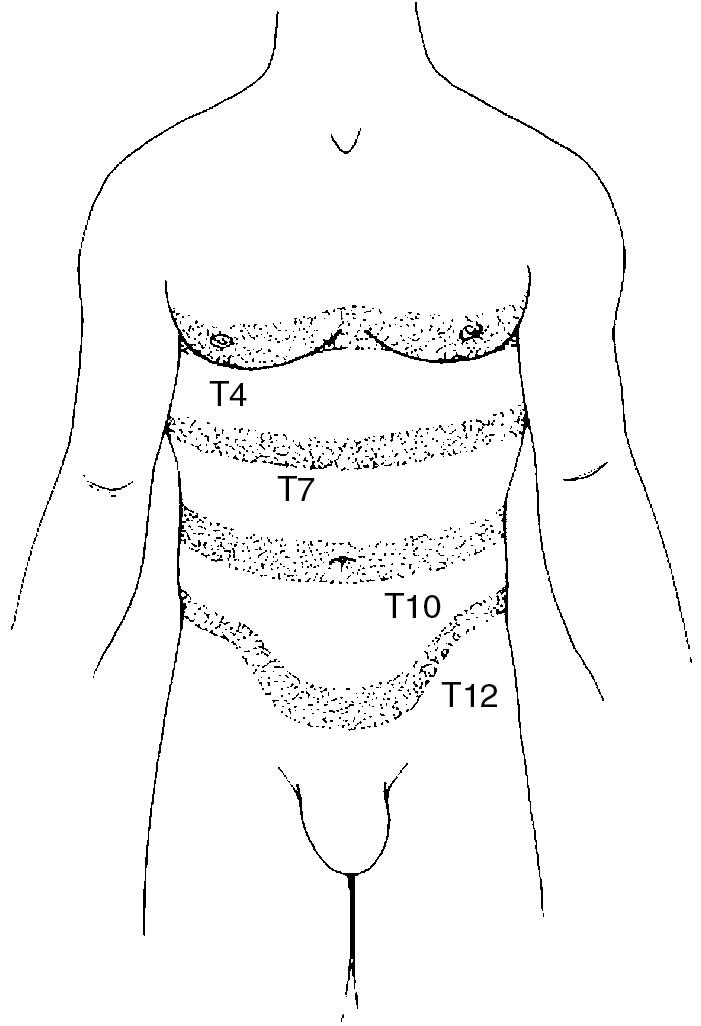Physical Address
304 North Cardinal St.
Dorchester Center, MA 02124
Pain and spinal deformity. The differential diagnosis of thoracic pain is extensive and includes both spinal and nonspinal etiologies. Spinal deformities (e.g., scoliosis, kyphosis) are generally painless in children but may become symptomatic in adult life.
Degenerative disorders: spondylosis, spinal stenosis, disc herniation
Fracture: traumatic, pathologic
Neoplasm
Infection: disc space infection, vertebral osteomyelitis, epidural abscess
Deformity: kyphosis, scoliosis, trauma
Vascular: arteriovenous malformation
Referred pain from a cervical spinal condition
Intrathoracic
Cardiovascular (angina, aortic aneurysm)
Pulmonary (pneumonia, carcinoma)
Mediastinal (mediastinal tumor)
Intraabdominal
Hepatobiliary (hepatitis, cholecystitis)
Gastrointestinal (peptic ulcer, pancreatitis)
Retroperitoneal (pyelonephritis, aneurysm)
Musculoskeletal/other
Post-thoracotomy syndrome
Polymyalgia rheumatica
Fibromyalgia
Rib fractures
Intercostal neuralgia
Soft tissue disorders (sprains, myofascial pain syndromes)
The patient should be undressed, and posture should be evaluated in both frontal and sagittal planes. Shoulder or rib asymmetry suggests the presence of scoliosis. A forward-bending test should be performed to permit assessment of rib cage and paravertebral muscle symmetry. If increased thoracic kyphosis is noted, it should be determined whether the kyphotic deformity is flexible or rigid. Leg lengths should be assessed. Look for any differences in height of the iliac crests. Note any skin markings such as café au lait spots, hairy patches, or birthmarks, which may suggest occult neurologic or bony pathology.
Palpation allows the examiner to locate specific areas of tenderness, which aids in localization of pathology. Tenderness over the paraspinal muscles should be differentiated from tenderness over the spinous processes.
Range of motion (ROM) is limited in the thoracic region, and precise assessment is not an emphasized component of the thoracic spine examination. Nevertheless, thoracic ROM is tested in all planes. Flexion-extension is limited by facet joint orientation, rib cage stability, and narrow intervertebral discs. Thoracic rotation is typically greater than lumbar rotation due to facet orientation. Testing of lateral bending is relevant in assessing the flexibility of thoracic scoliosis. Asymmetric ROM, especially in forward-bending, suggests the presence of a lesion that irritates neural structures, such as a tumor or disc herniation.
Sensory levels are assessed by testing for light touch and pin-prick sensation. The exiting spinal nerves create band-like dermatomes (T4, nipple line; T7, xiphoid process; T10, umbilicus; T12, inguinal crease) ( Fig. 5.1 ). Motor function is assessed by having the patient perform a partial sit-up and checking for asymmetry in the segmentally innervated rectus abdominis muscle. Upward movement of the umbilicus is consistent with isolated weakness in the lower portion of the rectus abdominis muscle (i.e., due to a spinal lesion between T10 and T12) and is termed Beevor sign. Reflex testing consists of evaluation of the superficial abdominal reflex.

The superficial abdominal reflex is an upper motor neuron reflex. It is performed by stroking one of the four abdominal quadrants. The umbilicus should move toward the quadrant that was stroked. The reflex should be symmetric from side to side. Asymmetry suggests intraspinal pathology (upper motor neuron lesion) and is assessed with magnetic resonance imaging (MRI) of the spine.
Clinically significant thoracic disc herniation is rare. It is difficult to reach an accurate diagnosis from history and physical examination alone. Thoracic disc herniations may cause thoracic axial pain, thoracic radicular pain, myelopathy, or a combination of these symptoms. Neurologic findings may include nonspecific lower extremity weakness, ataxia, spasticity, numbness, hyperreflexia, clonus, and bowel or bladder dysfunction.
Become a Clinical Tree membership for Full access and enjoy Unlimited articles
If you are a member. Log in here